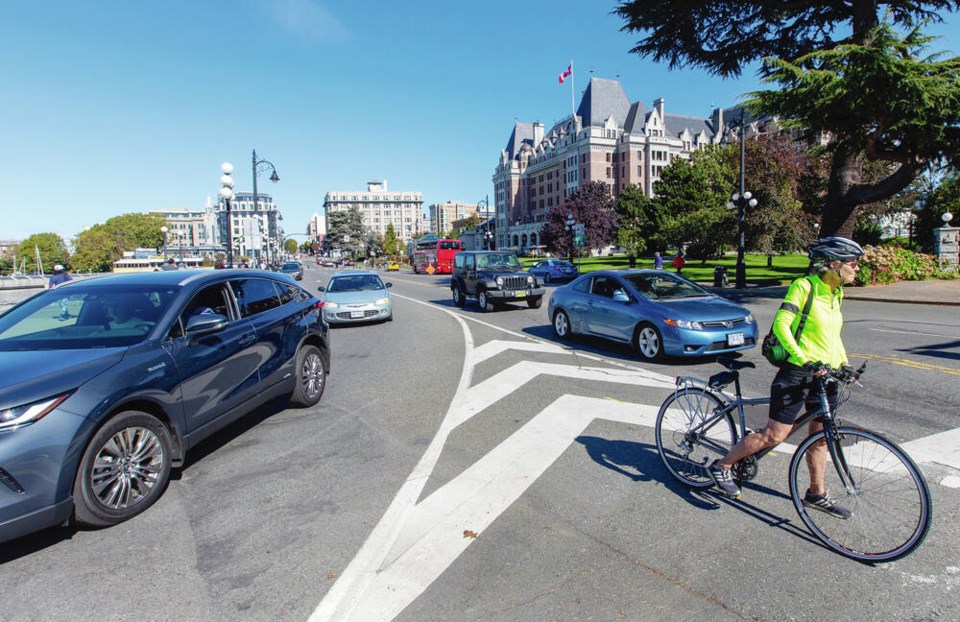A serious cyclist versus vehicle collision at Government and Bay streets on Monday morning last week snarled traffic for hours while police traffic analysts did their work. According to the police, the cyclist will require “significant treatment” in order to recover.
Putting the law aside for a moment, it’s actually irrelevant about who is to blame in a car versus cyclist collision. The cyclist will always come out the loser. A bike is never going to be a match for an opponent whose weight is measured in tonnes.
I rode fairly consistently until my mid 30s. As a kid in Calgary, my friend and I rode for hours, often well into the night. Those night riding forays once even earned us $2 fines from the gendarmerie for not having a light.
The fear of riding is actually irrational based on collision stats. But I gave it up anyway, mainly because I stopped feeling safe out there. There weren’t that many close calls, but there were enough to change my outlook. Those close ones were enough to tell me that even though I’d done nothing wrong, I wasn’t prepared to be “dead right” in the future.
It’s hard to believe based on the number of outright cycling transgressions a car driver sees, on any given trip, that cyclists and vehicles share equal amounts blame for being at fault in crashes, according to the B.C. Cycling Coalition. Several North American studies show the cyclist is less likely to be at fault in vehicle versus bicycle crashes.
There are a lot of simple, practical things a cyclist can do to cut down on their chances of being killed in a crash. Avoiding a crash in the first place should always be top of mind.
The red light is your enemy. Obviously, blowing through a red light on a bike is extremely dangerous but the danger also exists in other ways. Avoid sitting in the blind spot of a car stopped at a red and heading in the same direction as you. That car may make a right hand turn in front of you and because you’re in their blindspot — you’re invisible. Either pull up alongside so the driver has to see you or stay behind that car until clearing the intersection.
Use a headlight even in daytime. Decades ago North American auto regulators determined that “always on” headlight systems increased a vehicle’s visibility and reduced collisions. The same applies for bikes. Cycling with your headlight on makes it easier for drivers to see you. It’s especially important for left turning drivers to be aware before they turn directly into your path. Wearing high visibility clothing, all the time, also increases your chances of being seen out there.
Put a mirror on your bike. Being struck by a car from behind is not that common but it does happen. Having a constant view, and awareness, of what’s going on behind you is important. Cyclists are often struck when they manoeuvre quickly to avoid an object in the road and put themselves into the path of a vehicle behind them. A mirror gives you a better chance to see approaching vehicles and avoid them.
Don’t ride on sidewalks. Besides it being illegal, drivers don’t [and shouldn’t] expect bicycles to appear in front of them from sidewalks. Cars emerging from lanes or driveways have less time to react to a bicycle on the sidewalk moving at speed.
Slow down. It goes for both vehicles and bikes. Slower means more reaction time and less damage when impact does occur.
Ditch the headphones. You need all of your senses all of the time when riding.
Pretend you’re invisible. Assume that no one can see you and ride accordingly.
Glove Box: Al wrote in last week with his own timely reminder around bike safety. Vehicles turning right at intersections have new challenges because of the growing investment in new bike lanes throughout the region. Some vehicle drivers occupy those bike lanes when attempting to make a right turn. Usually this happens when there’s one vehicle waiting for a red light and the driver behind then passes on the right to complete a right turn — effectively blocking the bike lane. Often this requires driving over a solid white line, which is illegal.
For Al, there’s a clear need for more education and more explicit signage, alerting drivers to be aware and yield to cyclists coming up on their right hand side. A bike lane is a dedicated lane for travel and it affords the cyclist rights on our roadways the same as any other vehicle. Is the signage clear and consistent throughout the region? That’s a whole other question, which I’ll look at in a future column.
>>> To comment on this article, write a letter to the editor: [email protected]



